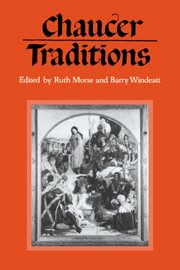Book contents
- Frontmatter
- Contents
- List of contributors
- Preface
- Note on the text
- 1 Chaucer traditions
- 2 Gower–Chaucer's heir?
- 3 Chaucer and Lydgate
- 4 Hoccleve and Chaucer
- 5 Chaucer and fifteenth-century romance: Partonope of Blois
- 6 Some Chaucerian themes in Scottish writers
- 7 The planetary gods in Chaucer and Henryson
- 8 Gavin Douglas: ‘Off Eloquence the flowand balmy strand’
- 9 Skelton's Garlande of Laurell and the Chaucerian tradition
- 10 Chaucerian metre and early Tudor songs
- 11 Aspects of the Chaucerian apocrypha: animadversions on William Thynne's edition of the Plowman's Tale
- 12 The shape-shiftings of the Wife of Bath, 1395–1670
- 13 The genius to improve an invention: transformations of the Knight's Tale
- 14 From the Clerk's Tale to The Winter's Tale
- 15 The Virtuoso's Troilus
- 16 Rewriting romance: Chaucer's and Dryden's Wife of Bath's Tale
- 17 Chaucer's religion and the Chaucer religion
- 18 A list of the published writings of Derek Brewer
- Index
15 - The Virtuoso's Troilus
Published online by Cambridge University Press: 23 September 2009
- Frontmatter
- Contents
- List of contributors
- Preface
- Note on the text
- 1 Chaucer traditions
- 2 Gower–Chaucer's heir?
- 3 Chaucer and Lydgate
- 4 Hoccleve and Chaucer
- 5 Chaucer and fifteenth-century romance: Partonope of Blois
- 6 Some Chaucerian themes in Scottish writers
- 7 The planetary gods in Chaucer and Henryson
- 8 Gavin Douglas: ‘Off Eloquence the flowand balmy strand’
- 9 Skelton's Garlande of Laurell and the Chaucerian tradition
- 10 Chaucerian metre and early Tudor songs
- 11 Aspects of the Chaucerian apocrypha: animadversions on William Thynne's edition of the Plowman's Tale
- 12 The shape-shiftings of the Wife of Bath, 1395–1670
- 13 The genius to improve an invention: transformations of the Knight's Tale
- 14 From the Clerk's Tale to The Winter's Tale
- 15 The Virtuoso's Troilus
- 16 Rewriting romance: Chaucer's and Dryden's Wife of Bath's Tale
- 17 Chaucer's religion and the Chaucer religion
- 18 A list of the published writings of Derek Brewer
- Index
Summary
Loquendi forma, scio, quòd mutata
Sit intra seculum; & verba mirè
Tune temporis in precio, & laudata.
Nunc vel in desuetudinem abire:
Amabant etiam tune (oportet scire)
Diuersis item saecis conciliare
Amorem: Artes variae sunt & rare.
Given a moment's thought, one recognizes that what is being said has a familiar ring, and perhaps recalls the source in English. The unusual but careful imitation of the rhyme scheme, and the ear for the rhythm of the original are strong clues. However when Chaucer wrote that ‘in forme of speche is chaunge / Withinne a thousand yeer’, and towards the end of his most ambitious work foresaw how the text of the Troilus might deteriorate, or become liable to misunderstanding over the years, he could scarcely have envisaged that before very long an able and well-meaning scholar-courtier would seek to provide the world with a parallel translation of the poem into Latin (together with a copious and erudite commentary) largely with the intention of protecting it from the ravages wrought by time through linguistic change.
Chaucer–s critical heritage and the editorial history of his writings have been amply treated in recent years, but it is rare to find the name of Sir Francis Kinaston (1587–?1642) given more than a cursory mention in such contexts.
- Type
- Chapter
- Information
- Chaucer TraditionsStudies in Honour of Derek Brewer, pp. 213 - 233Publisher: Cambridge University PressPrint publication year: 1990
- 3
- Cited by



